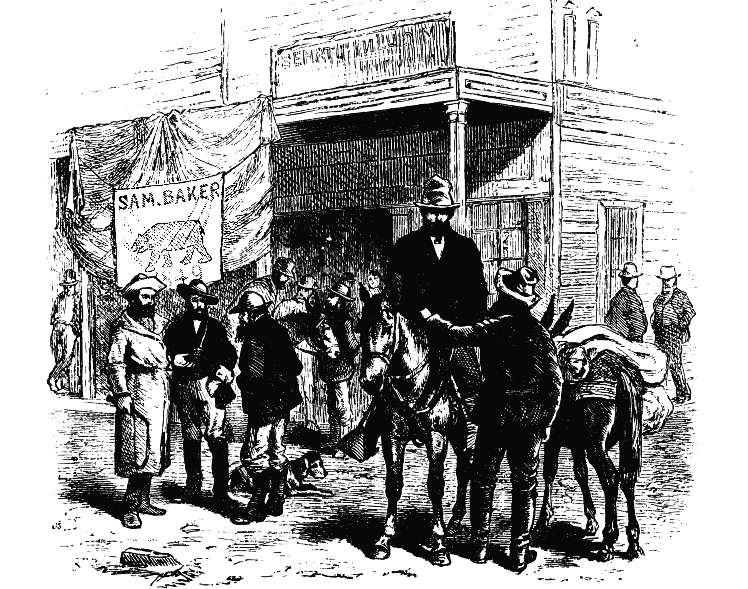Copyright 2021 by Gary L. Pullman
Source: Wikipedia
Nevada, has a lot more to do with the Wild West than might be apparent to those unfamiliar with the history of “The Silver State.” The impetuses that led to the founding of its towns, large and small, often indicate their role in the settlement of that part of the great American West that lies in and about the Great Basin and its immediate environs.
Using Highway 50, “The Loneliest Road in America,” as a handy route across the state, and raveling from east to west, we chart the towns that were settled during the nineteenth and early twentieth centuries, appreciating, in the process, how each contributed to the civilization of the Western frontier.
Source: Harry Shipler
Ely, the seat of White Pine County, was founded in 1906 as a stagecoach station on the Pony Express and Ventral Overland Route. Later, with the discovery of copper in the area, which supplemented earlier gold discoveries, Ely became a mining town subject to the ups and downs of similar boom towns.
Western points of interest in Ely include the Nevada Northern Railway Museum and the East Ely Depot.
Settled in 1864, the mining town of Eureka, a source of silver and lead, proved to be the second-most productive in the state, with only the famed Comstock Lode producing more ore. Unfortunately, Eureka's mines were played out by 1878, although “The Friendliest Town on the Loneliest Road in America” survives.
The California Gold Rush
is responsible for the settlement of Fallon,
which became the final stop of men whose intention of joining the
Forty-Niners in their search for California's gold but, instead,
called it quits after crossing the Carson River. The settlement was
named after local rancher Michael Fallon and his wife Eliza.
Wild horses near Stagecoach, Nevada. Source: YouTube.
As its name suggests, Stagecoach began as a station along the Overland Stagecoach route, which also served as a Pony Express station. Before 1857, when the Overland Stagecoach company was founded, U. S. mail was delivered to the West by way of steamers routed through Panama.
Source: Flickr
Of those towns on our list so far, Dayton is, in some ways, probably one of the most historic. Its original name, Ponderers Rest, recalls the pondering of travelers who rested here as they watered their animals and decided whether to follow the river southward or continue their journey to the west.
The population soared after gold was discovered at nearby Gold Creek, a Carson River tributary. To avoid California's tax, Chinese miners immigrated from the Golden State to the Silver State, and, when the Comstock Lode was discovered in 1859 and many miners traveled to Gold Hill and Virginia City to seek their fortunes, the number of Chinese workers in Dayton became great enough a year later that the settlement was renamed China Town.
It wasn't until 1861 that it was officially named Dayton, after John Day, a local surveyor who later became the Surveyor General of the United States. Thereafter, Dayton capitalized on its proximity to the Carson River by becoming the Comstock's major milling center, experiencing rapid growth. One of the “Great Fires” that occurred during the years 1866 and 1870 burned down much of the town, but Dayton survived, reduced both in size and importance, after the construction of the Carson & Colorado Railroad in 1881.
The Dayton Courthouse and the Union Hotel are among Dayton's places of interest to Western fans.
Source: Wikipedia
Finally, our trip west on Highway 50 brings us to Carson City. Named, in 1843, by John C. Fremont in honor of his scout Kit Carson, Carson City had its start as a Utah Territory trading post along the Carson Branch of the California Trail and was governed by Salt Lake City officials. The discovery of the Comstock Lode increased Carson City's population dramatically, and it became the seat of Ormsby County. Its Warm Springs Hotel, which has served as the territorial legislature's meeting hall, was converted into the region's first prison and remains part of this institution even today.
Nevada became a state in 1864, and Carson City became its capital. Its economic base switched from mining to commerce and railroad construction, in which Chinese workers played an enormous role. Although the building of the Central Pacific Railroad through the Donner Pass reduced Carson City's size and status, it remained an important frontier city into the twentieth century.
There are several places of interest for Western devotees, including several museums, the Stewart Indian School, the Sears-Ferris House, the Silver Saddle Ranch, the Mexican Dam, Prison Hill, and Lake Tahoe.
Mining, stagecoach lines, the Pony Express, politics, and railroads helped to settle the Western towns of Nevada, just as they helped to bring civilization to many other states of America's Wild West.
Next up: Western towns along Nevada's Interstate 80.










No comments:
Post a Comment